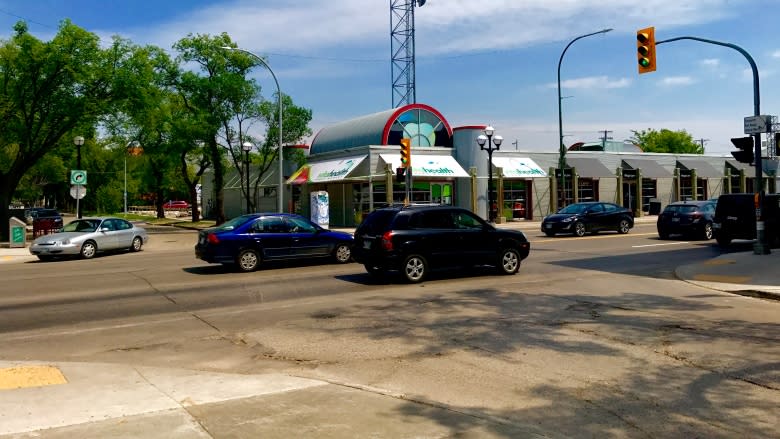Crosswalk where boy died could use 'aggressive treatment' with half-signal, says traffic expert
The Winnipeg crosswalk where eight-year-old Surafiel Musse Tesfamariam died after being hit on his way to school in February is getting upgrades, but they might not go far enough, says a pedestrian safety expert.
A report, which will be voted on next week by a city committee, advises pruning two elm trees to improve the visibility of the existing overhead crosswalk signs and flashing amber lights, which are sometimes easy for drivers to miss.
It also suggests installing rapid rectangular flashing beacons — RRFBs — which are mounted closer to eye-level and flash quicker, and have proven effective in other cities in getting drivers' attention.
City traffic experts have been examining how to improve pedestrian visibility and safety at the crosswalk on St. Anne's Road at Varennes Avenue since the crash that claimed Tesfamariam's life on Feb. 13.
The review found at least two other people had died and one person was injured at that same intersection between January 1980 and December 2016.
Half-signals a better approach: consultant
Jeannette Montufar, a former University of Manitoba professor in transportation engineering and a founding partner and CEO of MORR Transportation Consulting Ltd., applauds the move to increase safety.
"I think it is important that there is this added level of security that the city is planning on bringing to the location, where this fatality took place," she said, but added there is something better than the rapidly flashing rectangular beacons.
"I would want to see something more along the lines of a half-signal, which is a more aggressive treatment."
A half-signal is a traffic light that only turns red when pedestrians need to cross.
The city already has about 20, including at the intersections of Obsorne-Wardlaw and Osborne-Granite Way (at the foot of the bridge), and a handful on Portage Avenue.
The city review did consider installing a full four-way traffic light at the St. Anne's-Varennes crossing but found the volume of vehicles did not warrant it, according to the report.
A half-signal is an ideal compromise, said Montufar.
The rapidly flashing beacons are lofty in the hierarchy of pedestrian traffic control but the top spot belongs to standard traffic signals, since drivers are better conditioned to respond to red lights, she said.
Half-signals stay green until a button is pressed, then switch to amber and red, just like a regular traffic light, bringing cars to a full stop. The person crossing is then signalled with a "walk" sign.
It helps address the problem of pedestrians stepping out too soon into traffic, like they tend to do with crosswalks, assuming vehicles will stop.
The current St. Anne's-Varennes set up — a pedestrian corridor with an overhead flashing light — is typically a strong solution for safe crossings, but it has failed and "given us a problem resulting in a fatality," she said.
Differing opinions on intersection
"Running this pilot test of [RRFBs] may result in improved security and reduce the probability for collisions in the future," but perhaps it's time to make it as safe as possible, which means bringing in a red light, Montufar said, "so that we can ensure that people know exactly when they have the right-of-way at that location."
How rectangular rapid flashing beacons work:
City Coun. Brian Mayes, whose ward includes the crosswalk, said he has never received as many calls and emails from residents about the intersection as he did after the death of Tesfamariam.
That's why he wanted to get the process rolling as soon as possible to improve the crossing.
He said there are different opinions on what to do at that intersection, including from Montufar's husband — and the city's former traffic planner — Luis Escobar.
Mayes said in 2012, Escobar, who now works for a private firm, did not support the idea of a traffic light at the intersection.
"He made no suggestion at that time a half-signal should be installed, nor was that suggestion ever communicated to me at any time during his period overseeing traffic for the City of Winnipeg.
"I have followed the steps needed to get action taken at this intersection to promote safety, and I'm pleased some action is being recommended."
However, Escobar disputed the subject of the 2012 exchange with Mayes.
He said Mayes had come to him after receiving a complaint from a constituent who wanted a traffic signal at Regal Avenue and St. Anne's Road — just south of Varennes — to help cars get onto St. Anne's Road.
The former traffic planner told CBC News on Saturday the councillor's request "had nothing to do with pedestrian activity."
Escobar said the request did not come to anything because it was determined there were already enough traffic signals between Regal and Fermor Avenue, a few blocks to the south.
Jim Berezowsky, the city's director of public works, said the RRFBs will enable to city to act quickly to make the improvements in time for the start of school in the fall.
"It's an innovative solution that we can deploy almost immediately," he said, adding the half-signal would require more time because it would require more infrastructure to install and the road to be broken up.
The RRFBs will simply be added to the crosswalk already in place.
"What we're doing is bringing another level of safety at that eye-level height," Berezowsky said.
The city report's recommendations will be voted on by city council's standing policy committee on infrastructure and public works on June 26.




